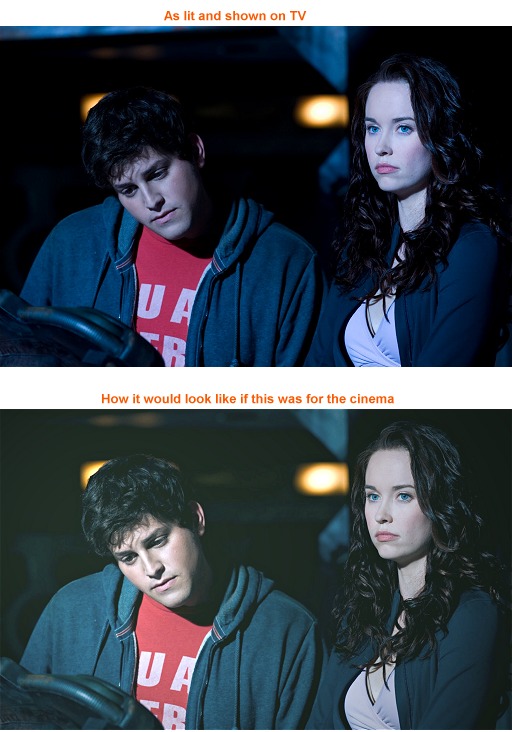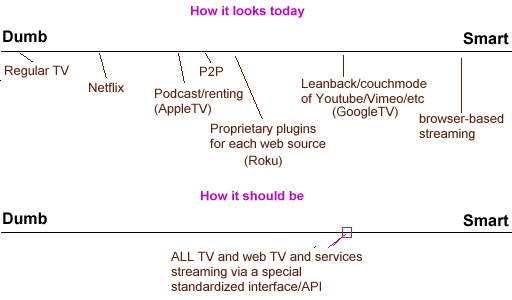I bought the Roku XD|S a month ago (my review of it), and the only service I mostly watch on it, is Vimeo. I watch it even more than Netflix, Amazon on Demand, and the newly released on Roku, Hulu Plus. And unlike these services, Vimeo is free, and the quality of the clips there is astounding! It’s food for your brain, and for your eyes. Vimeo’s (good) clips are pure art.
I would wholeheartedly and honestly advise every filmmaker, artist, or video enthusiast to buy the cheap version of Roku (Roku HD, $60), just for Vimeo. Do this even if you’re in Europe, and most of the other Roku services are not available there. Just get it for Vimeo alone: the price is right, and most modern PAL TVs can playback NTSC content anyway! The other versions of Roku that do 1080p don’t matter, since the vast majority of the Vimeo videos are in 720p, or lower. As a bonus, you will also get a YouTube channel, just in case you want to watch on TV whatever’s not on Vimeo (meaning, mostly crap).
Quality is great on my 50″ Pioneer plasma TV. Especially when viewing a video originated from a “clean” source footage (e.g. a timelapse that its source were still pictures), or the video was encoded by Vimeo in 1080p (~4 mbps VBR h.264), the quality is way better than Comcast’s, which averages 1080i at 12 mbps mpeg2 CBR!
Sure you can watch Vimeo on TV via your computer’s TV-out (if your PC has HDMI-out in the first place), but it’s not the same experience. You would constantly need to reach your computer to select another video, and Flash’s h.264 playback occasionally stutters even on the fastest PCs, even with hardware acceleration. Roku’s h.264 implementation is smooth as butter and its usability feels like real TV, not some hack that has to share resources with other PC services.

The Vimeo service on the Roku
Going a bit further than that, I would love to see a Vimeo TV channel. Either a traditional TV channel to be given-away via cable/satellite, or a more modern one, via an application for Roku/GoogleTV/etc that can stream “live” video (live meaning, not on-demand). Keep the current Vimeo TV versions that lets you login, “like”, watch your channels/groups etc, but also provide a “live” channel playing the best-of-the-best videos 24/7. The CouchMode can co-exist, but since it runs through a browser, navigation is a bitch and it offers a crappy experience (on GoogleTV, pressing “menu” brings up Chrome’s menu for example, not Vimeo’s).
The reason why I’d like a Vimeo “live” (non-ondemand) channel on top of Roku’s Vimeo channel and CouchMode is because these services only let me watch my own “likes”, and the Staff-Picks/HD Channels only, while I’m more interested in more good content than just that. I want someone else (Vimeo) to go through the best of the best of all time, and show them to me instead of the comparatively small selection that currently exists in the above mentioned lists/channels. Sure I can search for videos myself, but I can’t know if what I’m getting is good or not. Vimeo can do the picking for me. I just want to turn ON the TV, and watch goodness, stuff I possibly never watched before, without me having to search for it. Let me explain. This is how I envision the Vimeo TV channel:
– Take any video with over 299 views, longer than 29 secs, and divide its number of “completed” views to its number of Vimeo “likes”. All videos uploaded after 2009 that produce less than “200” as resulted score, can be green-lit to be shown on the live Vimeo TV stream. For pre-2009 videos to get shown, the score must be less than “100”, because people kept “liking” easier in the past. Some of my early videos in 2007 got more “likes” than they deserved, for example. Either that, or people are more difficult to “like” these days — whatever the case, I have observed differences in “like” habits, probably because after the dSLR revolution more good stuff are uploaded today than back then.
Here’s a video that only has 460 views so far, but it has 58 “likes”, creating a score of “8.1” (which is super-high score). There are many hidden gems on Vimeo like this one!
– One 30 second TV commercials after the end of each video shown. Show two commercials if the video that follows is more than 10 minutes long. Don’t show ads on top of videos. Don’t cut off full movies for commercials, unless you can work something out with the copyright owner. TV commercials pay way more than web ads, so that should be Vimeo’s incentive to create a TV channel.
– Show information of the video following in a black screen for about 8-10 seconds, with a title, thumbnail, credits, date uploaded, description, CC license if applicable, HD or not, new or not, etc. It would be nice to also show the median score too, so we known if what’s coming is a masterpiece, or just plain good… 😉
– Using Vimeo’s “Categories“, Vimeo can categorize each video into these categories, so it can have hourly “programs”. For example, you get the documentaries in 6 PM, the short films at 8 PM (primetime), music videos after 11 PM, etc etc. For web TV series, they can even be shown from 9-10 PM, every weekday, for about 5 minutes each (since they don’t usually last more than that). Every weekend there can also be a 3-hour marathon of the best-scored clips of the week. Of course, most uploaders never add their videos on these “Categories” (were you even aware of that Vimeo feature? I wasn’t until recently), so some interns need to get employed and go through sorting these green-lit well-scored videos. From that point on, creating actual “thematic programming,” is a go.
– Vimeo (like YouTube) already has a perpetual license to broadcast videos people upload to it, so I don’t see why they shouldn’t. If you don’t like this arrangement, remove your video from Vimeo. Easy as pie.
– Later, if this whole experiment works, Vimeo can become a studio itself, and produce hour-long scripted shows. Stay away from reality crap though — let that remain YouTube’s sin. Vimeo is about art. Shooting in NY is very expensive though, so this might be something that has to happen elsewhere.
– Finally, this step is important: have two versions of live Vimeo. One that upscales everything to 720p, and one that upscales everything to 1080p. Meaning, don’t change resolution depending on the video shown, just upscale it. The 720p version ensures compatibility with more devices (e.g. the cheap version of Roku, AppleTV via Boxee), and the 1080p version allows TVs that have a native dot-by-dot mode to watch the videos in 1:1 size, without any overscan. See, when a video with a non-1080p resolution changes the TV’s 1080p native resolution, the TV is getting thrown out of its native dot-by-dot mode (better quality), so we need to reach for our remote control and re-set it for every video. This is what happens now on both my Roku and my GoogleTV. And is very annoying.
– For broadcasting/upscaling, every clip that was green-lit for Vimeo TV will need to get re-encoded. Re-encoding the 2 mbps Vimeo video would have a huge impact on quality, so these clips must be re-encoded from source instead, with more bitrate.
![]()





